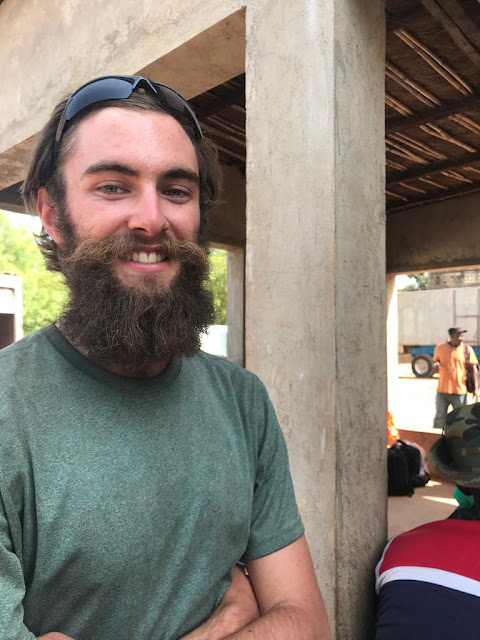During the last full week of April, I attended Cashew In-Service Training (Cashew IST) in Toubacouta along with about 30 other Peace Corps Senegal Volunteers from all over the country. We met in Toubacouta, a village in the Fatick region of Senegal, for three days to learn about cashews.
The first day of the training was spent in a classroom learning about the basics of cashew propagation, harvesting, orchard management, and nutrition. We took a field trip on the second day to a 40-hectare local cashew orchard for some hands-on demonstrations of harvesting, identifying pests, and eating cashew apples. In the afternoon we learned about beekeeping and its importance for establishing a successful cashew orchard. On the third and final day of Cashew IST, we visited a local cashew processing plant to see how the product is transformed from the raw cashew nut (RCN--this green-shelled nut is what you harvest from the tree) into the cashew kernel we are familiar with seeing in grocery stores.
I have formatted this blog post slightly differently than usual; instead of writing about what I learned here, I have included some information about cashews in longer captions accompanying the pictures below.
 |
| Waiting for the bus in Kedougou |
 |
| On the bus driving through Niokolo-Koba National Park on the way to Cashew IST. Half of the road through the park is paved, but half is dirt (and very dusty). I am on the left with the white shirt over my face. I was not aware this picture was being taken. |
 |
| On the bus |
 |
In Toubacouta with my color-changing T-shirt
|
 |
| Mangroves near the hotel in Toubacouta. The Fatick region of Senegal is located on a delta that drains into the Atlantic Ocean. Mangroves line the shore of much of the coastline that I saw. Due to the tides and high water table, salt-water intrusion into groundwater is a big problem in some areas of Fatick |
 |
| Looking back at our hotel from the dock. This place is beautiful, and it's the middle of hot season! I can only imagine how pretty it is here in the months after rainy season when everything is green |
 |
| The tide is out |
 |
| Cashews fallen from the a tree. The best way to harvest cashews is to wait for them to fall to the ground and pick them up daily. If cashews are picked off the tree, the RCN will not be fully developed |
 |
| A perfectly ripe cashew apple. The apple ripens before the RCN, so unfortunately many cashew apples are overripe by the time the RCN/apple combination falls to the ground |
 |
| An even better-looking cashew apple than the one above. Some varieties are yellow when ripe, others are various shades of red/orange |
 |
| Large cashew trees. Many trees in the orchard are over 25 years old |
 |
| Collecting cashews off the ground and looking for signs of diseases/pests |
 |
| Red cashew apples hanging from the tree, waiting to drop |
 |
| A bee box in the orchard that currently does not have bees. Cashew orchards need to have bees nearby because the flowers cannot be well-pollinated by wind alone. Orchards with bees can have more than double the fruit production of orchards without bees. During Cashew IST we learned the basics of how to do beekeeping with local materials. I am very interested and, if it fits into the scope of my other projects, might give it a whirl after the rainy season |
 |
| Grafting practice |
 |
| A pile of rotting cashew apples. Cashew apples are very juicy, have soft skin, and ferment very quickly. Cashew apples are difficult to transform for these reasons; transforming cashew apples into usable products is made even more difficult because they are overripe when the RCN falls and is collected. Cashew apples need to be separated from the RCN within 24 hours of falling from the tree or else they can cause the kernel inside the RCN to rot. As the vast majority of the value of the cashew comes from the RCN, cashew apples are usually left to rot in a pile like this. Some apples are occasionally transformed into juice or wine, but this requires extra manpower and machinery |
 |
| At the processing plant--separating good RCN from bad RCN by hand |
 |
| Good RCN on the tarp. Bad RCN (in the bucket) are disfigured or small. If you try to crack them with the cracking machines at this facility, the kernel inside will break. Broken kernels have drastically less value than whole kernels. The bad RCN will be sent to a different facility that can accommodate their non-optimal shape/size. |
 |
| 40kg of RCN are steamed at a time in the oil-drum vessel in the foreground. Sticks are being added to the fire in the middle ground. In the back left of the picture is a pile of cashew shells. The discarded shells are used as fuel for the fire. Cashews are steamed for about one hour then dried for 1-3 days. After drying, they are ready to be cracked. If they are not dried enough, the shell will not crack properly. If they are too dry, the kernel inside will break when the nut is cracked |
 |
| The steamer is assembled. Pile of discarded cashew shells again in the foreground on the left |
 |
| The junction between the top and bottom sections of the steamer are sealed with a mixture of wood ash and water to prevent heat from escaping |
 |
| Cashew cracking machines |
 |
| Cracking some cashews, following the example of the Senegalese woman to my right. After the nuts are cracked, a thin skin needs to be peeled off the kernels (similar to the skin of a peanut).This cashew skin contains the same compound as poison ivy, hence the gloves to prevent skin damage. We did not practice peeling the skin off of the kernels, so sadly I do not have a picture of that process |
 |
| My friend Mary and I cracking cashews |
 |
| Spotted in Toubacouta (at a tourist-focused store that makes Moringa and cashew products)--a solar dish cooker! |
 |
| Working hard, even on our last evening in Toubacouta |





























Comments
Post a Comment